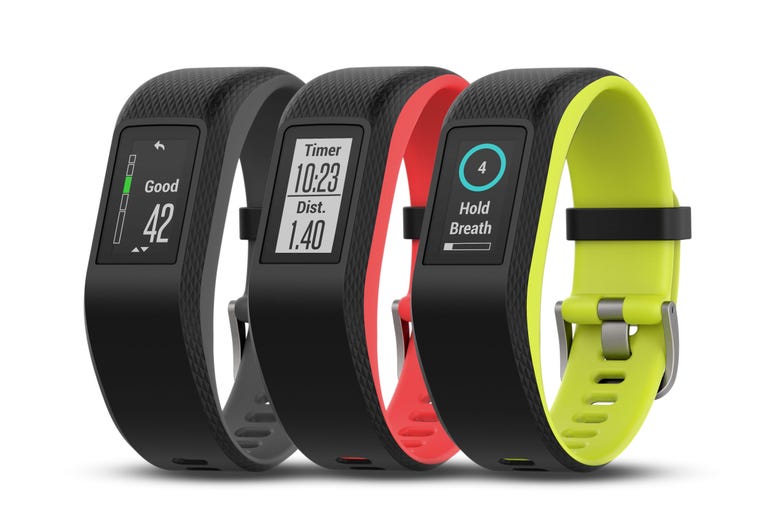 Why You Can Trust CNET
Why You Can Trust CNET Garmin Vivosport review: Garmin Vivosport's price drop makes it more appealing
This slim "smart" activity tracker features GPS, a heart-rate monitor, color touch-screen and 15 built-in apps.
Depending on your point of view, you can call Garmin's Vivosport a high-end fitness band or an entry-level sports smartwatch. It started out too pricey at $200 (£170, $AU300) but after being on the market for several months, its price has come down online, making it a better value.
The Good
The Bad
The Bottom Line
The Vivosport has a robust feature set for a fitness band, and according to Garmin it gets up to 7 days worth of battery life. I was regularly able to go 6 days between charges when not using GPS. Like Garmin's other smartwatches and activity trackers, this model is fully waterproof and can be used while swimming .
I found it slim and very comfortable wear. The band is pretty thin -- perhaps a bit too thin for people who have big, thick wrists. I liked its look and feel on my normal-to-thinner wrists, however, especially since I find that some of the other watches just feel too big.
The Vivosport packs a lot of features into its slim design.
Along with a built-in optical heart-rate monitor that seems pretty accurate, there's GPS tracking, an always-on color touchscreen display, notification alerts and 15 built-in sports widgets for everything from strength training to cycling and cardio.
Unfortunately, because the display is small, it can be a little tricky to navigate through all the widgets and settings. At least the touchscreen is significantly more responsive than the monochrome touchscreen found on the lower-priced Vivosmart 3.
In a lot of ways the Vivosport is simply a better version of the Vivosmart 3. The two models have similar features, but the Vivosport adds the aforementioned GPS and LiveTrack5, a feature that tracks your activity and location in real time and sends alerts to designated friends and family members, telling them where you are on a web-based map.
The Vivosport automatically tracks activity, including steps, floors climbed, calories burned, intensity minutes, sleep and more. As part of its 24-7 heart-rate monitoring, the device will measure your heart-rate variability and translate it into a stress level, then prompt you to breathe and relax when that level is elevated.
The Vivosport is available in 3 color options with different band sizes.
Like the Vivosmart 3, this model estimates VO2 max, a measurable indication of aerobic performance that was previously available only in higher-end Garmin running watches. Your VO2 max score translates into a fitness level, ranging from poor to superior, and it's also used to calculate your fitness age, "a relatable metric that puts a user's fitness level in terms of an age" according to Garmin.
I have some small complaints about the GPS. It can take a while to sync up and get going -- it took good two-and-a-half minutes for me the first time. The lock-in time cuts down to a little less than 20 seconds once you've done the initial sync with your phone, but it still felt a little sluggish.
If you're a serious runner you'll probably want to step up to Garmin's Forerunner or Fenix series watches. But for more casual runners like me, the Vivosport is fine.
Overall, I liked the Vivosport a lot, and I think it's a good option for people with smaller wrists who want an activity tracker that has plenty of advanced features. I don't think it's worth $200 but I've seen it for $150 online and even less for refurbished units. It's a lot more appealing at those price points.
Here are the Vivosport key specs:
- Always-on color touchscreen display.
- Up to 7 days of battery life (8 hours in GPS mode).
- Can be worn while swimming or showering (waterproof).
- 24/7 heart-rate monitoring.
- High-end fitness monitoring tools such as VO2 max and fitness age and wellness monitoring with all-day stress tracking.
- Automatically tracks activity, including steps, floors climbed, calories burned, intensity minutes, sleep and more.
- New Strength Training activity keeps track of reps, sets and even rest times during your free weight and bodyweight exercises.
- Includes LiveTrack5, a feature that alerts designated family members and friends where you are during your workouts in real time using the built-in GPS.
- Move IQ automatically recognizes activities like walking, running, biking, swimming and elliptical training, and records the activity.
- Once synced with Garmin Connect, these recorded activities are viewable as part of a detailed timeline.
- Automatically syncs with the Garmin Connect mobile app throughout the day to save stats.
- Available in black/slate (small/medium and large), black/fuchsia (small/medium only) and black/limelight (large only).
- You can control music on your phone from the Vivosport, send an alert to locate a misplaced smartphone, and remote control a Garmin VIRB camera (sold separately).


